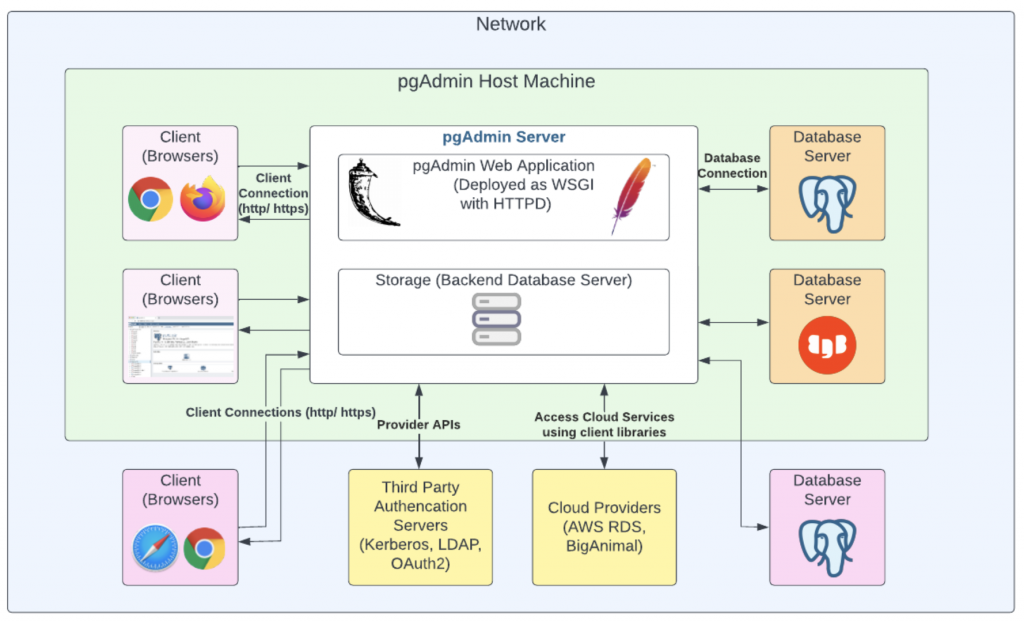
- Pgadmin 4 docker how to#
- Pgadmin 4 docker install#
- Pgadmin 4 docker software#
- Pgadmin 4 docker password#
- Pgadmin 4 docker download#
none - no network is assigned to a container.host - the network on your computer any container on this network is.bridge - the default network for a container, it represents a virtual,.The database port that PostgreSQL will run on.
Pgadmin 4 docker password#
The password for the "postgres" user in your database instance, which is the root user. This user will have access to PG_DATABASE The username of the default user in the database instance. The name of the default database to create in the database instance. The password for the PG_PRIMARY_USER in your database instance. Sets the username of the superuser for your database instance. Other options include "replica" for creating a read-only instance, as well as "set" for creating a StatefulSet in a Kubernetes cluster
Pgadmin 4 docker how to#
What do all of these settings do? SettingĪ parameter just for crunchy-postgres that determines how to setup this PostgreSQL instance. Using your favorite textĮditor, create a file in the postgres directory called called pg-env.list and

We will create one volume for our PostgreSQL 10 environment: docker volume create -driver local -name=pgvolumeĪs mentioned mentioned earlier, we need to pass in some settings to properlyĬonfigure our Docker container to run PostgreSQL. Now, we need to create a folder to store the data for our PostgreSQL instance.īy default, Docker containers do not persist data beyond the lifecycle of a What I did on my computer: mkdir postgres Let's create a directory on your computer to work from. To help you optimize how you run your database. Image, which uses the community version of PostgreSQL and passes in several That require different PostgreSQL usernames and passwords to access each For example, you may want to create several docker containers Images allow you to pass in variables in order to configure settingsĭynamically, which is useful if you want to deploy your containers across Snapshot of the filesystem of the application you want to run. We need to get an image of PostgreSQL in order to run a container. There areĪ few things we need to do before we can get PostgreSQL up and running.
Pgadmin 4 docker install#
Dockerįrom the URL below, or use your favorite package manager to install Docker onto Isolated instances of applications with all of their dependencies. Source containerization platform, which allows developers to create and run In order for this recipe to work, you need to be usingĭocker.
Pgadmin 4 docker download#
The Detailed guide Part 1: Download Docker Run the following commands in your terminal: tl dr: Quick setup for PostgreSQL 10 & pgAdmin 4 1. To get up and running, the tl dr guide is just below. Some light on how to work with Docker and PostgreSQL. So I wrote a detailed guide explaining each part of the process to help shed While going through this process, I was also learning how to better use Docker, One of our engineers gave me a recipe to setup While I was trying to find things to experiment with using Docker,
Pgadmin 4 docker software#
The open source software ecosystem around PostgreSQL is as robust as theĭatabase itself, but sometimes it can be hard for people new to PostgreSQL, andĮven some seasoned veterans, to get all of the software dependencies for theirĭevelopment environment setup on their computers.Īt Crunchy Data, we obsess on making things asĮasy as possible for people to get software up and running, regardless of the Now you can create postgreSQL databases in pgadmin4.Easy PostgreSQL 12 and pgAdmin 4 Setup with Docker! We enter the data indicated by docker-compose.yaml Now let's connect the postgreSQL database server to pgadmin4. In the connection details for the hostname, specify the postgreSQL container name or the mail that was specified in PGADMIN_DEFAULT_EMAIL and the root password To configure pgadmin - open a browser and go to. To view the logs, use the command docker logs -f postgres Now you can use the container IP with port 54320, or the name of the postgres container with port 54320 (IP:54320 or postgres:54320) to connect the database. We are waiting for the download of images, and deployment. Run our script (for this you need to be in the directory where our file was created. PGADMIN_DEFAULT_PASSWORD: password for the pgadmin user ĥ050:80: the port on which pgadmin is running. PGADMIN_DEFAULT_EMAIL: mail/user for authorization in pgadmin POSTGRES_PASSWORD: password for the user we are creating POSTGRES_USER: The user for the database being created Let's use the repository to create the docker-compose.yaml file at Ĭreate a docker-compose.yaml or docker-compose.yml file, You can also use a different directory to host this and other projects. To navigate in the future in what we have installed, let's create a separate folder for this project in the /home directory and go to it. Let's create a *.yaml file for Docker-Compose. Curl -L "$(uname -s)-$(uname -m)" -o /usr/local/bin /docker-compose


 0 kommentar(er)
0 kommentar(er)
